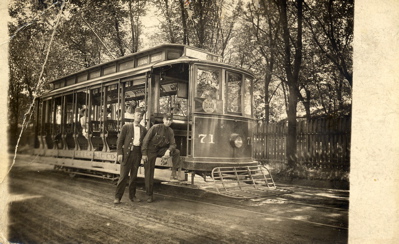Encyclopedia Dubuque
"Encyclopedia Dubuque is the online authority for all things Dubuque, written by the people who know the city best.”
Marshall Cohen—researcher and producer, CNN
Affiliated with the Local History Network of the State Historical Society of Iowa, and the Iowa Museum Association.
UNION ELECTRIC COMPANY: Difference between revisions
No edit summary |
No edit summary |
||
| Line 15: | Line 15: | ||
In 1913 it was announced that the company had purchased two electric "omnibusses" to operate between Dubuque and East Dubuque, Illinois. The cars were said to be electrically heated and lighted. | In 1913 it was announced that the company had purchased two electric "omnibusses" to operate between Dubuque and East Dubuque, Illinois. The cars were said to be electrically heated and lighted. | ||
In 1916 | In 1916 [[DUBUQUE ELECTRIC COMPANY]] took over the operation of Union Electric. | ||
See: [[UNION PARK]] | See: [[UNION PARK]] | ||
Revision as of 03:31, 8 August 2013
UNION ELECTRIC COMPANY. Incorporated on August 13, 1900, to provide ELECTRIC POWER to Dubuque, the company was the consolidation of two street railway systems, the Rhomberg line and the Allen & Sweeney line, STAR ELECTRIC COMPANY and the HOME ELECTRIC COMPANY which furnished electricity for light and power. (1)
The company listed as its officers Frank D. STOUT, president; William S. MOLO, vice-president; E. A. Engler, secretary; George W. Kiesel, treasurer; and W. J. Brown, manager. Stockholders included all the officers and John Peter ELLWANGER, B. E. Linehan, Peter KIENE, Charles H. EIGHMEY, and Benjamin William LACY.
Capitalized at $1,382,000, the Union Electric was unique in its lack of need for money from outside investors. No bonds were issued as the incorporators treated the stock as a personal investment and paid for improvements themselves. Immediately after forming, the company began tearing out old tracks and got rid of old STREETCARS replacing both with up-to-date equipment.
In 1902 the company provided half-fares to all patrons using the line between 6:15 and 7:45 a.m. and 5:15 and 6:45 p.m. after the City Council approved a twenty-five year franchise for the company. An order for eight new cars was placed with the St. Louis Car Company in time for summer use with the plan of offering five minute service on Main Street. Other improvements included the construction of a new car barn and power station. (2)
A strike of motormen and coachmen during the summer of 1903 lasted for seven weeks and resulted in the Iowa governor, his state labor commissioner, the president of the state labor federation, and a battalion of national guard troops to the city. (3)
Union Electric announced in 1905 that meters were being placed on their street cars. (4) Company officials stated that these were to see where electricity ("juice") was being lost. A secondary potential for the meters was to see whether drivers were using too much power. In going down hills,"instead of letting the car drift of its own momentum, they throw it onward at a terrific and dangerous rate of speed." (5) The newspaper concluded that while drivers in some cities were rewarded for their careful use of power, it was doubtful that this would happen in Dubuque.
In 1911 Dubuque residents were among the few in the United States to have "two rides for a nickel." Dubuque was also the only city in Iowa where a ten minute service was in operation all day long, every day of the year and where a five minute service was maintained during the rush hours from 6:00 to 8:00 a.m., 11:30 to 1:00 p.m. and 5:00 to 7:00 p.m. Union Electric operated 17.5 miles of street railway track and maintained seventy cars in service to handle traffic. All the cars were electrically heated which was not common in the industry. When the "pay as you enter" cars were introduced, Dubuque was the first city in the United States operating "single trunk" cars to adopt the plan. Union Electric also provided light and power to all parts of the city. UNION PARK, operated by the company, was the only park of its type in the United States maintained exclusively by a street railway company.
In 1913 it was announced that the company had purchased two electric "omnibusses" to operate between Dubuque and East Dubuque, Illinois. The cars were said to be electrically heated and lighted.
In 1916 DUBUQUE ELECTRIC COMPANY took over the operation of Union Electric.
See: UNION PARK
---
Source:
1. "Alderman Wallis on Equalization," Telegraph Herald, Dec. 20, 1914, p. 26
2. "Put Into Effect," Telegraph Herald, March 7, 1902, p. 3
3. "Story of the Strike," Telegraph Herald and Times Journal, March 24, 1933, p. 14
4. "Will Put Meters on Cars," Telegraph Herald, Aug. 19, 1905, p. 12
5. Ibid.


